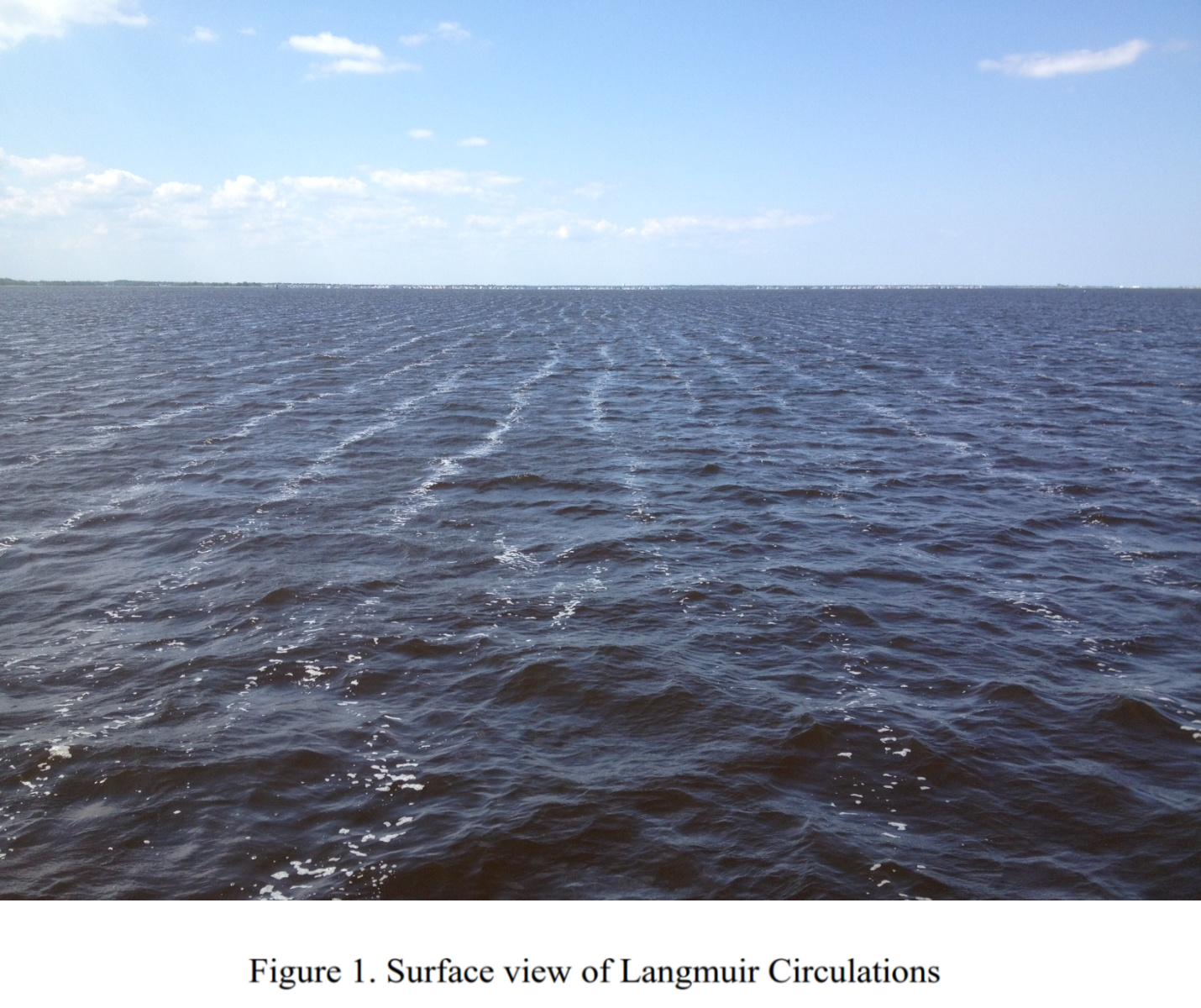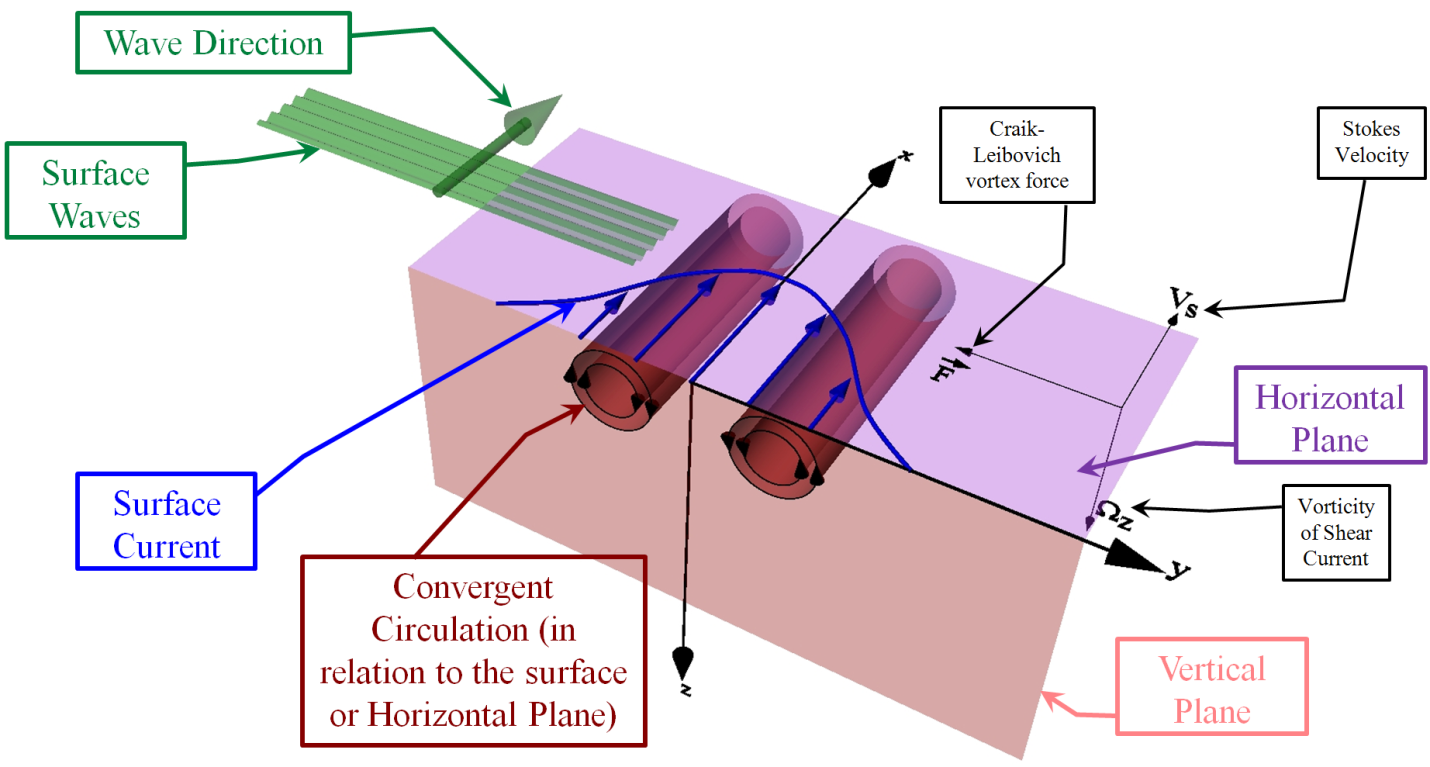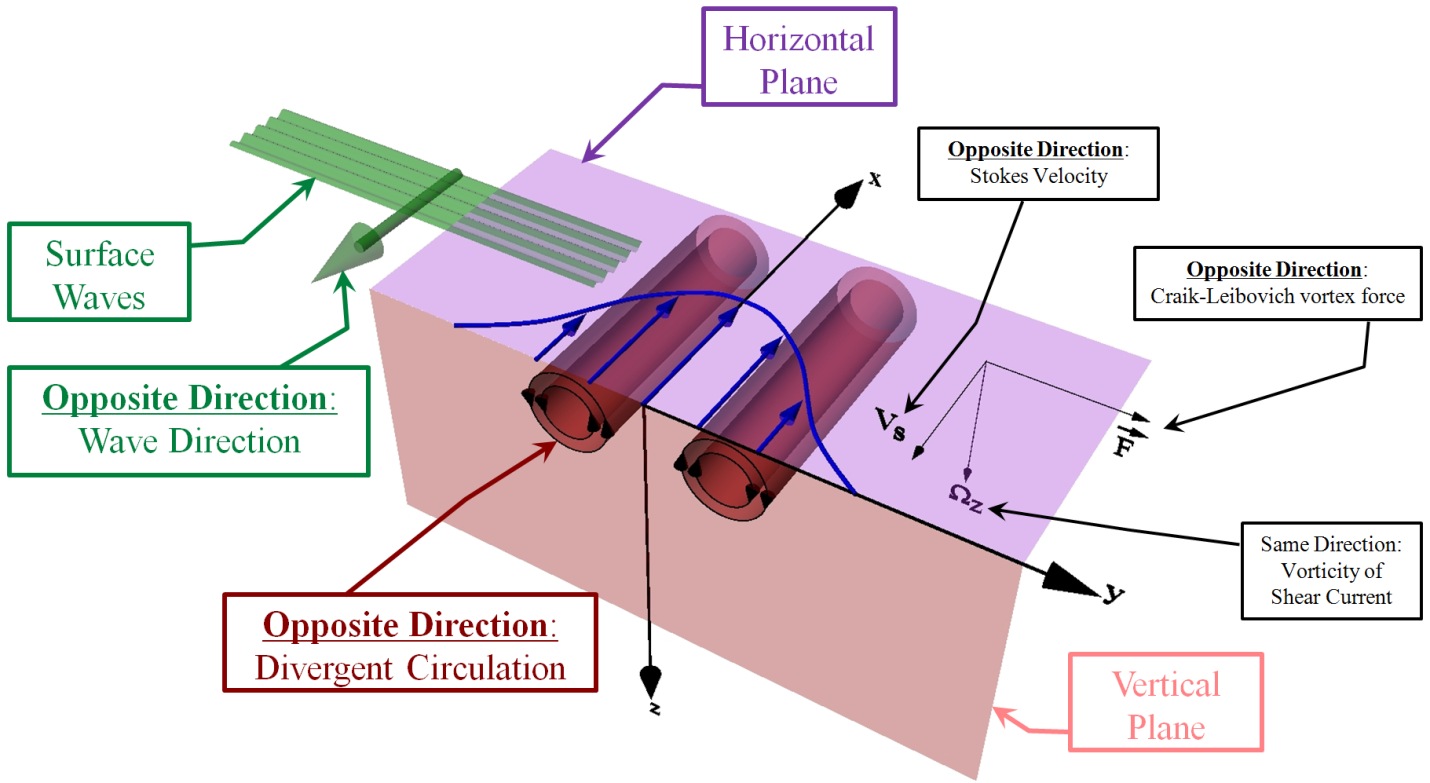Oceanographic & Atmospheric Science
Langmuir Circulations
Our knowledge of physics of the oceanic mixed layer can empower our clients to better understand the surface manifestations of underwater phenomena/processes. Cortana has recently made major contributions to the study of one of the most important phenomena in the upper ocean: circulations produced by the interaction of non-uniform currents with long ambient surface waves. A classic example of such phenomena is Langmuir circulations (LC). LC appear at the ocean/sea surface as a system of streaks aligned roughly with the direction of the wind. The surface streaks (Figure 1) usually contain foam, seaweed, and organic films and may visibly modify the spectra of the short surface waves.

Figure 1. Langmuir Circulations
http://professorsak.com/2013/06/
The streaks are produced by paired circulations, which are generated by an instability of wind-driven surface shear currents interacting with surface waves. The circulations themselves are generated by a so-called "vortex force" that can be imposed on a non-uniform current that is within the influence of ambient surface waves. The streaks correspond to the flow convergence regions produced by two adjacent circulations, since the component of surface velocity transverse to the streak is directed toward the streak. The component of the surface velocity along the streak, which is roughly parallel to the wind, is higher in the streak than in the surrounding areas. The areas of high and low surface velocity, which coincide with the areas of convergence and divergence of the circulations, are often called surface jets and surface wakes, respectively.
An instability mechanism leading to formation of LC, which results from a local reduction in drag due to an increased concentration of bubbles in the areas of convergence, has been identified by Cortana (A. Basovich, J. Phys. Oceanogr., 44, 2739-2752, 2014). This new model of the development of LC is quite different from the traditional Craik-Leibovich model. The Basovich model explains many observed LC features not previously understood, including the characteristic scale of the circulations with the maximum growth rate.
Other Langmuir Type Circulations
In addition to the classic case of environmentally driven Langmuir Circulations, similar circulations can occur as a result of the interaction of ambient surface waves with extrinsic non-uniform currents, such as industrial outflows and ship wakes. The existence of these Langmuir-type circulations (LTC) had been predicted by Cortana (A.Basovich, J. Phys. Oceanogr., 51, 151-164, 2011). Manifestations of such circulations are generated around a ship wake and frequently have been reported experimentally in the literature (see for example, Ermakov, Kapustin, Lazareva, Proc. of SPIE vol. 9240, 2014). While there are multiple hypotheses in the literature as to the source of these circulations, Basovich has shown that the direction of flow in LTC produced by a ship wake depends on the direction of the ship-generated current relative to the propagation direction of the surface waves. This well-founded explanation is consistent with the spatial scales of the data collected under a variety of ship and environmental conditions. It has also been shown that the magnitude of the circulatory flow, which depends on the ship velocity and on the amplitude as well as the direction of the surface waves, can reach several centimeters per second.
In the simple case of a fast moving ship, when the dominant contribution to total drag is from the wave making component, the wake can be modeled as a near-surface jet current. The interaction of the jet current and the surface wave field produces a pair of counter-rotating circulations as shown in Figure 2. The circulations are converging when the jet is collinear with the direction of the propagation of the ambient surface waves (head seas, ship travels into the seas) and are diverging in the opposite case (following seas, ship travels with the seas). The circulations are weakest when the ship current is near normal to the direction of the surface waves. Due to the large scales (on the order of tens to hundreds of meters across the pair) the LTC generated by the ship wakes should be expected to persist much longer than the original wake currents.

Figure 2. (A) Convergent Circulations
(A)

Figure 2. (B) Divergent Circulations
(B)
Figure 2. Langmuir type circulations (LTC) resulting from interaction of a jet with surface waves
In the case of a slower moving ship, a smaller percentage of the energy expended through propulsion is necessary to overcome the wavemaking component of the total drag as the drag current generated by the hull due viscous drag becomes relatively more significant at slow speed. Flow in the drag component of the ship wake is in the direction of ship travel, which is opposite to the jet (thrust) current and it is located outside of the thrust jet. This "duplex" structure of the ship thrust and drag currents, when interacting with the ambient surface waves, will generate two pairs of LTC: an inside or thrust generated pair and an outside or drag pair, as shown schematically in Figure 3. Here the outside pair is generated by the interaction of the long surface waves with drag component of the wake, which is reduced relative to the thrust component, which must also overcome the drag due to wave making. The Kelvin wave field is not shown for clarity and simplicity in the LTC schematic.

Figure 3. Two pairs of Langmuir Type Circulations.
Figure 3. Schematic of the two pairs of LTC (Kelvin wave field not included)
Recognizing the Influence of the Dynamic Ocean
The LTC described herein can be also generated due to interaction of the surface waves not only with ship wakes, but with underwater non-uniform currents of any origin, such as by currents modified by the bottom topography of the ocean, a strait, or a channel (A.Basovich, J. Phys. Oceanogr., 51, 151-164, 2011). The resulting circulations (LTC) also can be a transport mechanism for subsurface processes and contaminants that are either produced in, or migrate through buoyancy into, the ocean strata that are influenced by surface waves. The interaction of these circulations, either directly with the water surface or with a pycnocline below the surface can alter the ocean surface depending on the ambient wind and wave conditions as well as the thermal and haline gradients. Our expanding insight to these phenomena can be applied to illuminate some of the unexplained surface manifestations observed to date and help to better characterize the interaction of the ambient ocean with underwater processes as well as their effects on the ocean surface and within the marine boundary layer.
Citations
A.Basovich. The Effect of Contaminant Drag Reduction on the Onset and Evolution of Langmuir Circulations. J. Phys. Oceanogr. 44, 2739-2752, (2014). doi:10.1175/JPO-D-13-0228.1
A. Basovich. Circulations caused by interaction of underwater currents and surface waves, Dynamics of Atmospheres and Oceans 51,, 151-164, (2011). doi:10.1016/j.dynatmoce.2011.04.001
Ermakov, Kapustin, & Lazareva. Ship wake signatures in radar/optical images of the sea surface: observations and physical mechanisms. Proc. of SPIE vol 9240, (2014). doi:10.1117/12.2067367